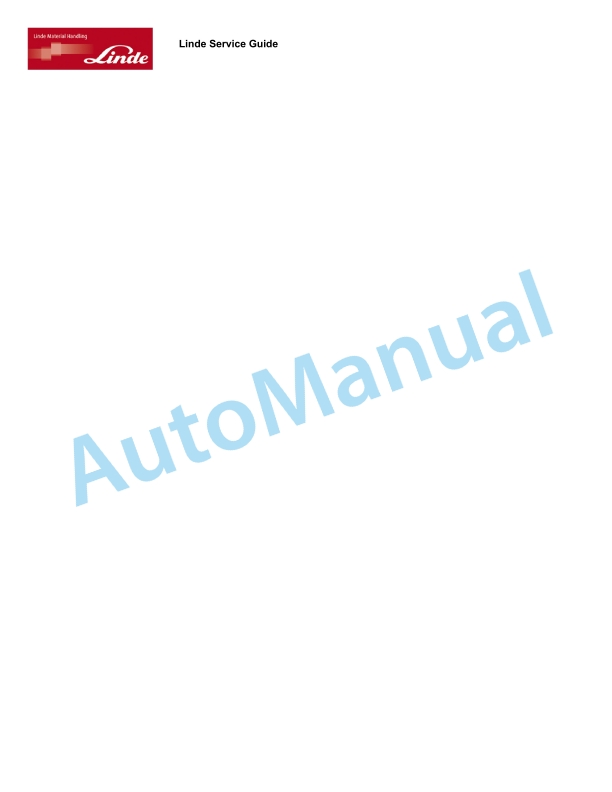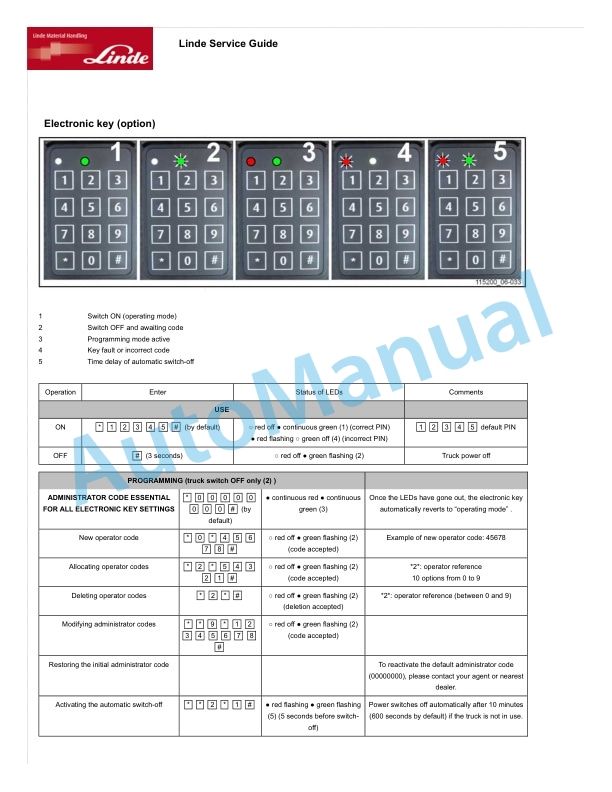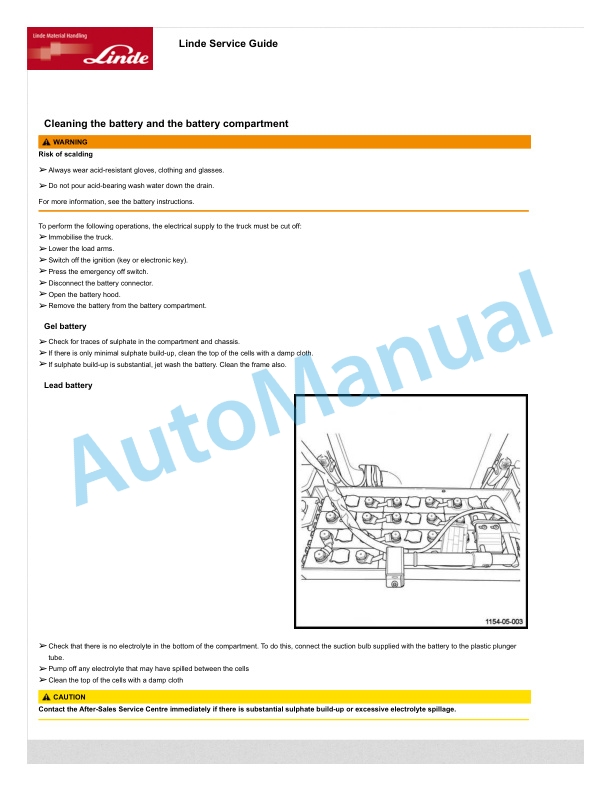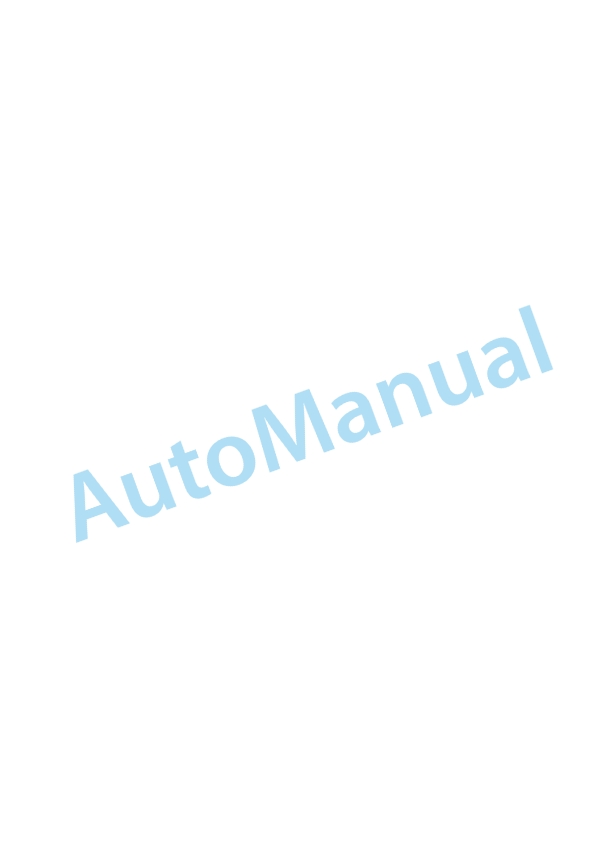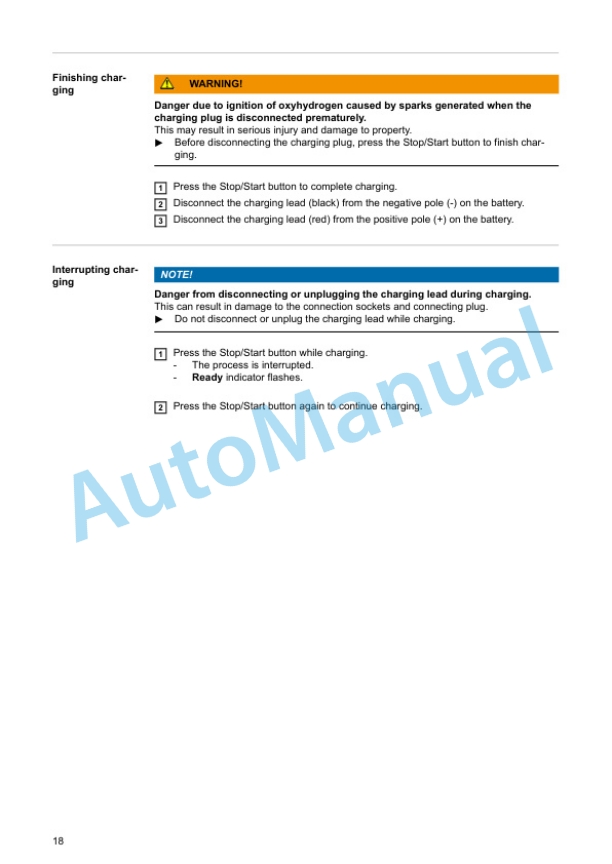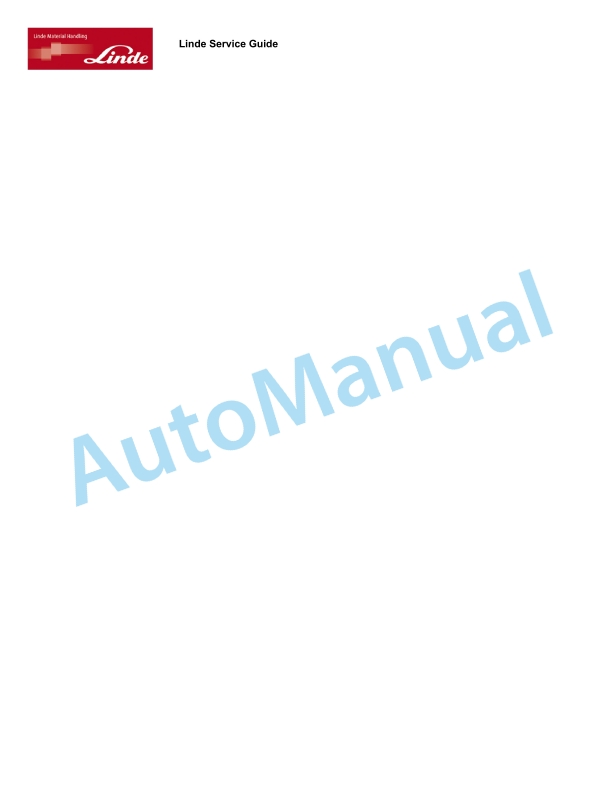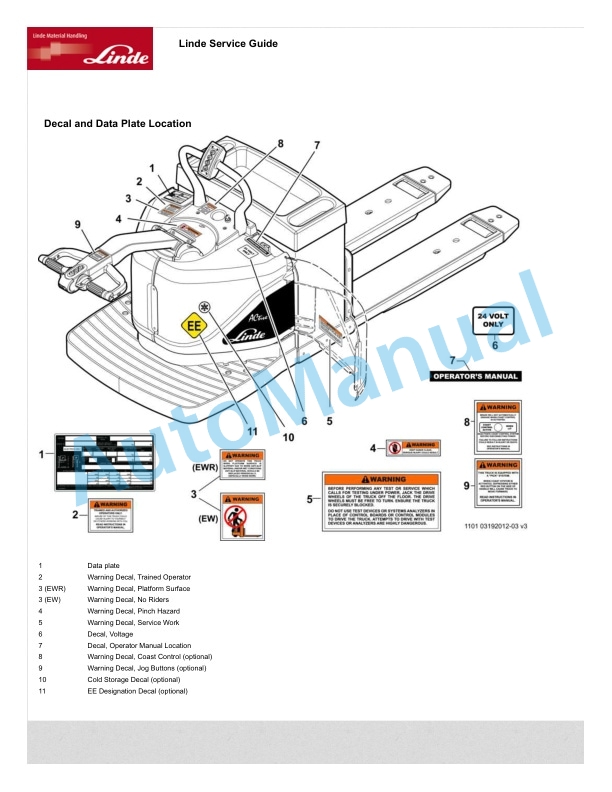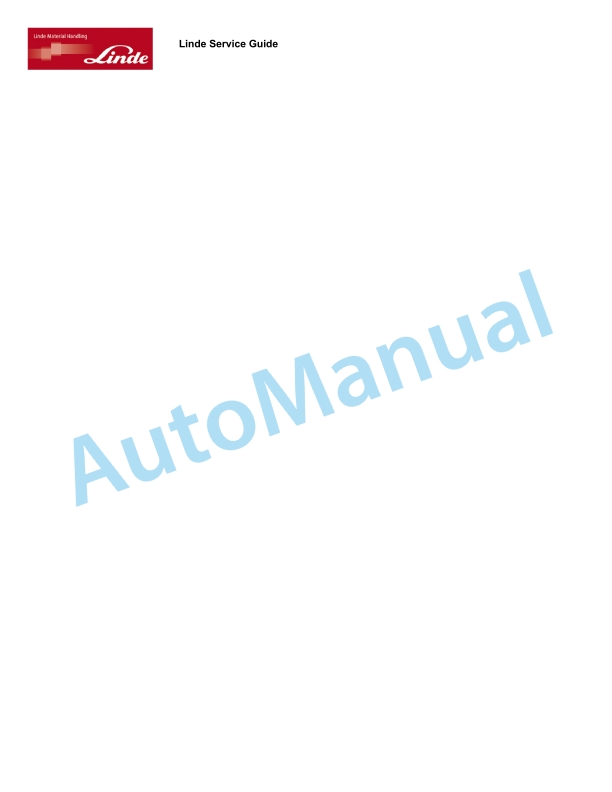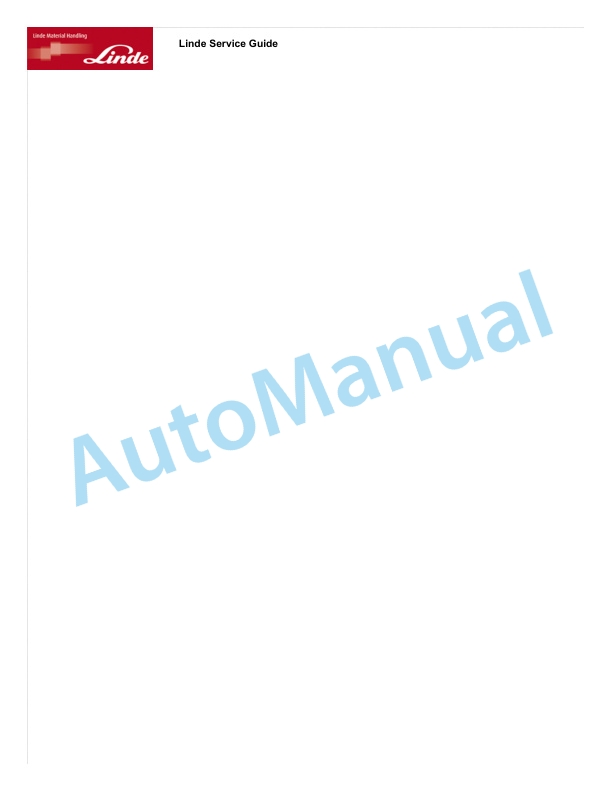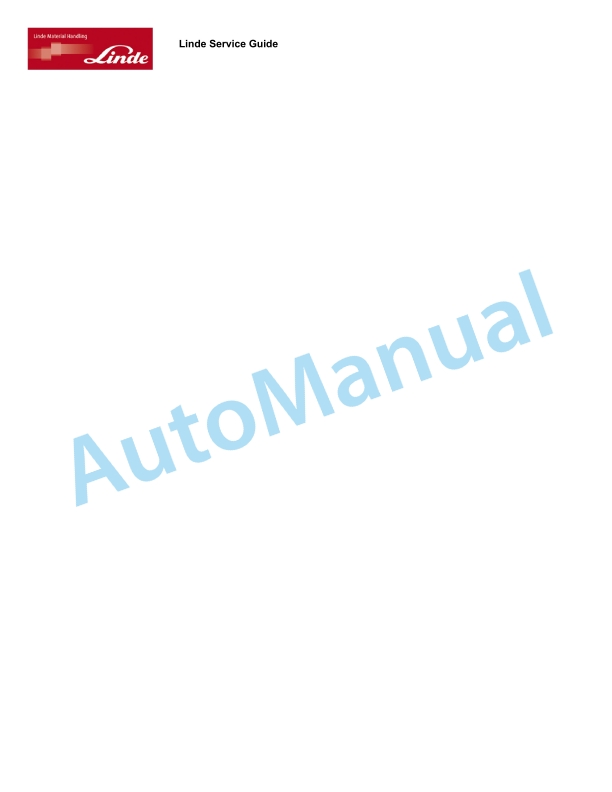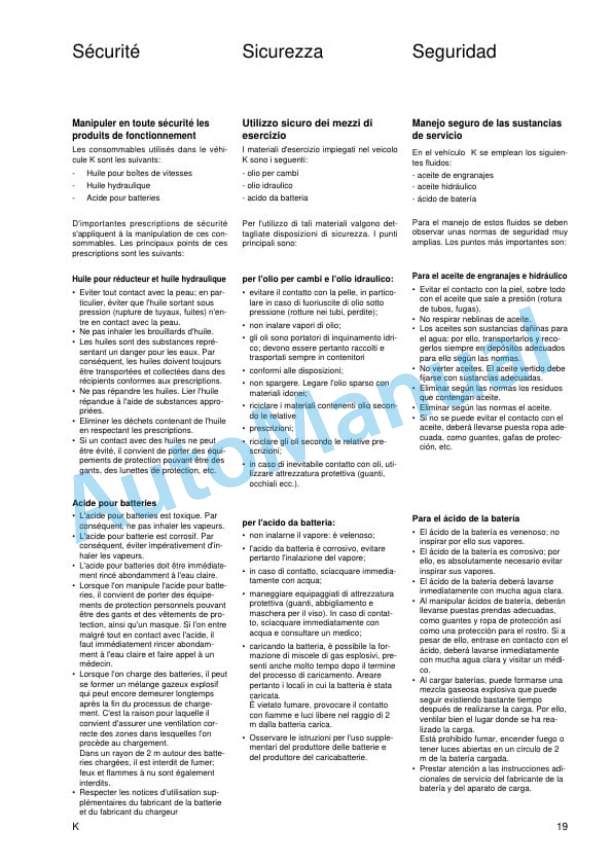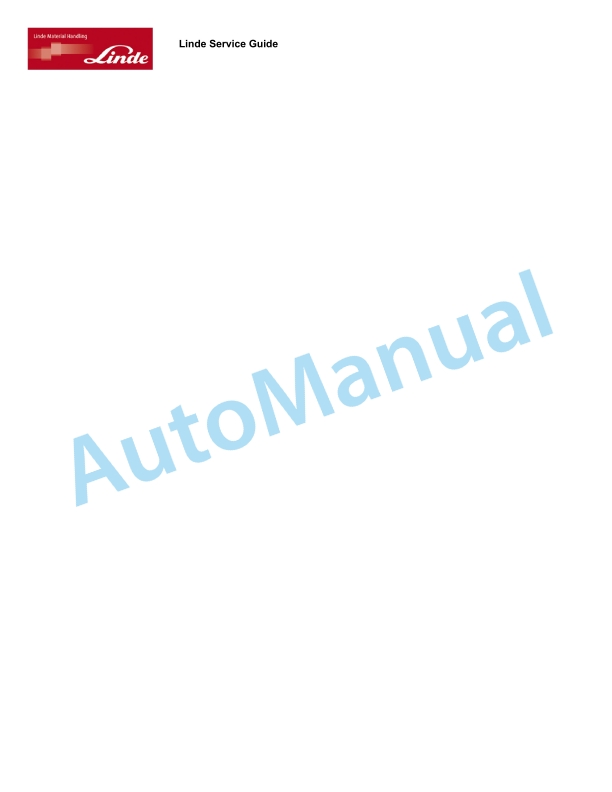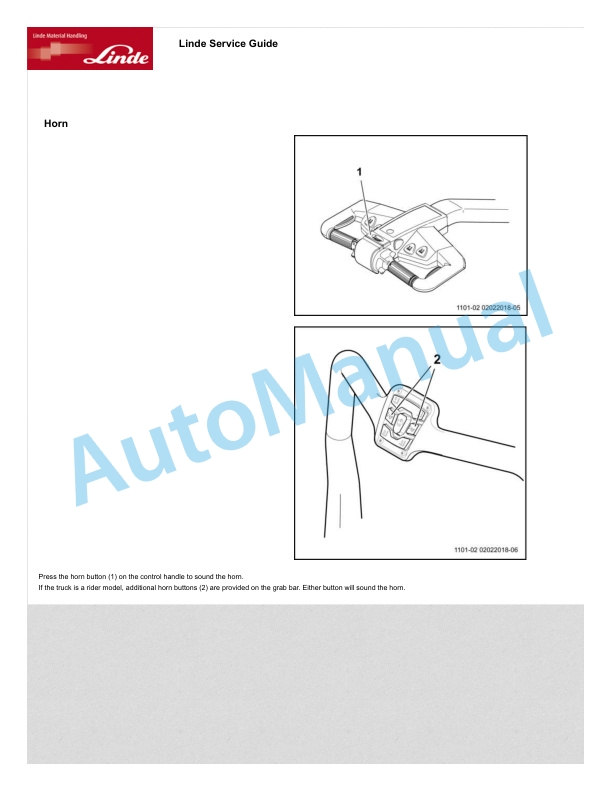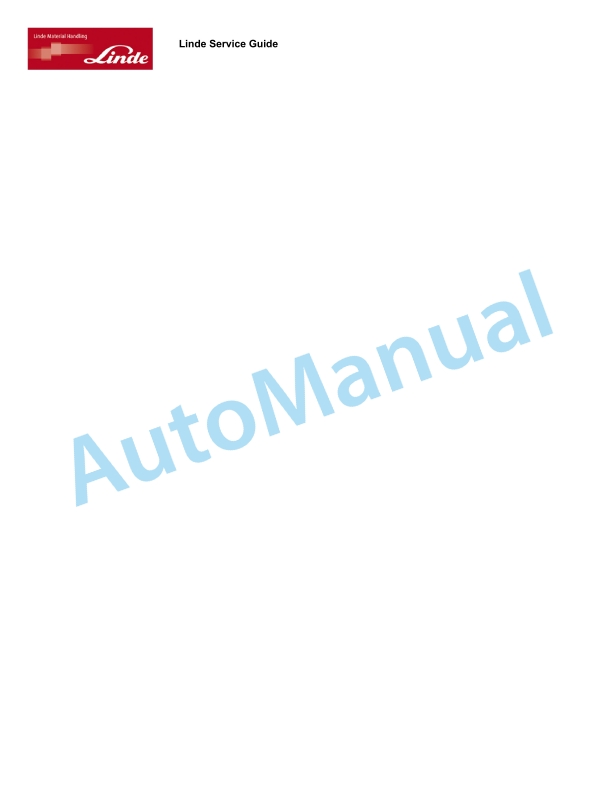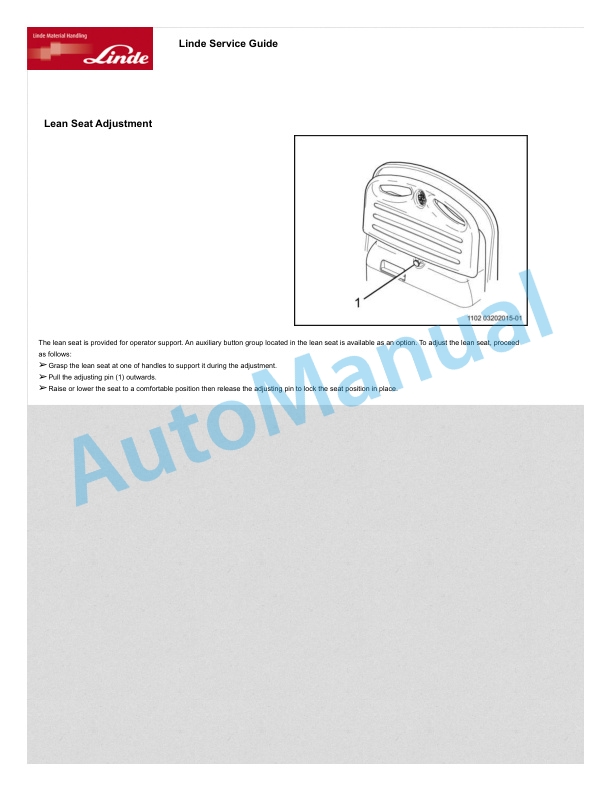Linde 1163-01 – D10, D10 AP, D10 AP-B, D10FP Operating Instructions SN W41163V00060 and up
$20.00
- Type Of Manual: Operating Instructions
- Manual ID: SN W41163V00060 and up
- Format: PDF
- Size: 53.3MB
- Number of Pages: 482
- Serial Number:
SN W41163V00060 and up
Category: Linde Operator Manual PDF
-
Model List:
- D10
- D10 AP
- D10 AP-B
- D10FP
- 1. V lithiumion batteries
- 1.1. Table of content
- 1.2. Introduction
- 1.2.1. Important information about the compatibility of the lithiumion battery and truck
- 1.2.2. Before using the truck
- 1.2.3. Important information about this manual
- 1.2.4. Identification label on the lithiumion battery
- 1.2.5. Correct use
- 1.2.6. Dangerous misuse
- 1.2.7. Productspecific risks
- 1.2.8. Information on the conformity of lithiumion batteries
- 1.2.9. Explanations of terms and symbols
- 1.2.10. Qualification of the user
- 1.2.11. Description of use and climatic conditions
- 1.3. Safety
- 1.3.1. Battery management system and safety
- 1.3.2. What to do in an emergency
- 1.3.3. Firstaid measures
- 1.4. General views
- 1.4.1. General view of 24V LiB batteries from 1.7 to 3.5
- 1.4.2. General view of the 24V LiB 7.1 battery
- 1.4.3. General view of the 24V LiB battery from 10.6 to 14.2
- 1.5.1. Description of the battery
- 1.5.2. Safety guidelines
- 1.5.3. Status of the battery on delivery
- 1.5.4. Transport mode
- 1.5.5. Connecting the battery to the truck
- 1.5.6. Switching on the battery
- 1.5.7. Modes of operation
- 1.5.8. Temperature conditions for operating . charging
- 1.5.9. Charging the battery
- 1.5.10. Changing the lithiumion battery
- 1.5.11. Switching off the battery
- 1.5.12. Resolving battery faults
- 1.5.13. Transporting lithiumion batteries
- 1.6. Maintenance
- 1.6.1. Regular maintenance
- 1.6.2. Service plan
- 1.6.3. Cleaning the battery
- 1.6.4. Transporting and storing within the company
- 1.6.5. Disposing of batteries
- 1.7. Technical specifications
- 1.7.1. Lithiumion battery datasheet
- 2. Double pallet stackerD10, D10 B, D10 AP, D10 AP B
- 2.1. Table of content
- 2.2. Introduction
- 2.2.1. Your truck
- 2.2.2. Conformity marking
- 2.2.3. Declaration that reflects the content of the declaration of conformity
- 2.2.4. Identification label
- 2.2.5. Correct use
- 2.2.6. Description of use and climatic conditions
- 2.2.7. Impermissible use
- 2.2.8. Symbols used
- 2.2.9. Taking delivery of the industrial truck
- 2.2.10. Rules for the operating company of industrial trucks
- 2.2.11. Disposing of gel and lead batteries
- 2.3. Safety
- 2.3.1. Safety regulations
- 2.3.2. Handling consumables
- 2.3.3. Emissions
- 2.3.4. Residual risks
- 2.3.5. Stability
- 2.3.6. Competent person
- 2.3.7. Periodic general checks on the trucks
- 2.4. General views
- 2.4.1. General view on a pedestrian truck
- 2.4.2. General view on a rideon truck
- 2.4.3. Controls
- 2.4.4. Display
- 2.4.5. Black and white display
- 2.4.6. Electronic key (option)
- 2.4.7. Labels
- 2.5.1. Technical description
- 2.5.2. Checks before first commissioning
- 2.5.3. Preshift checks before starting work
- 2.5.4. Daily checks before starting work
- 2.5.5. Truck operating instructions
- 2.5.6. Display
- 2.5.7. Driving regulations
- 2.5.8. Driving without platform (pedestrian model)
- 2.5.9. Driving with platform (rideon model)
- 2.5.10. Using the truck on a slope
- 2.5.11. BlueSpot
- 2.5.12. Best Value option Specific features of the truck
- 2.5.13. connect access system (LFM)
- 2.5.14. Transporting loads
- 2.5.15. Driving assistance system Speed Management
- 2.5.16. Cold store usage (optional)
- 2.5.17. Before leaving the truck
- 2.5.18. Gel and lead battery
- 2.5.19. Handling the truck in an emergency
- 2.5.20. Handling the truck in specific situations
- 2.6. Maintenance
- 2.6.1. General information
- 2.6.2. Technical data for inspection and maintenance
- 2.6.3. Recommended lubricants
- 2.6.4. Easily accessing the technical compartment
- 2.6.5. Regular maintenance
- 2.6.6. Service plan
- 2.6.7. Chassis, bodywork and fittings
- 2.6.8. Transmission
- 2.6.9. Steering and wheels
- 2.6.10. Electrical equipment
- 2.6.11. Hydraulic systems
- 2.6.12. Lift mast
- 2.6.13. Storage and disposal
- 2.7. Datasheet
- 2.7.1. D10 pedestrian model datasheet
- 2.7.2. D10 rideon model datasheet
- 2.7.3. D10 mast types
- 2.7.4. Ecodesign requirements for electric motors and variable speed drives
- 3. Double pallet stackerD10 FP
- 3.1. Table of content
- 3.2. Introduction
- 3.2.1. Your truck
- 3.2.2. Conformity marking
- 3.2.3. Declaration that reflects the content of the declaration of conformity
- 3.2.4. Identification label
- 3.2.5. Correct use
- 3.2.6. Description of use and climatic conditions
- 3.2.7. Impermissible use
- 3.2.8. Symbols used
- 3.2.9. Taking delivery of the industrial truck
- 3.2.10. Rules for the operating company of industrial trucks
- 3.2.11. Disposing of gel and lead batteries
- 3.3. Safety
- 3.3.1. Safety regulations
- 3.3.2. Handling consumables
- 3.3.3. Emissions
- 3.3.4. Residual risks
- 3.3.5. Stability
- 3.3.6. Competent person
- 3.3.7. Periodic general checks on the trucks
- 3.4. General views
- 3.4.1. General view of the truck
- 3.4.2. General view of the technical compartment
- 3.4.3. Controls
- 3.4.4. Display
- 3.4.5. Black and white display
- 3.4.6. Electronic key (option)
- 3.4.7. Labels
- 3.5.1. Technical description
- 3.5.2. Checks before first commissioning
- 3.5.3. Preshift checks before starting work
- 3.5.4. Daily checks before starting work
- 3.5.5. Truck operating instructions
- 3.5.6. Adjusting the handlebar height
- 3.5.7. Display
- 3.5.8. Driving regulations
- 3.5.9. Driving
- 3.5.10. BlueSpot
- 3.5.11. connect access system (LFM)
- 3.5.12. Transporting loads
- 3.5.13. Driving assistance system Speed Management
- 3.5.14. Cold store usage (optional)
- 3.5.15. Before leaving the truck
- 3.5.16. Gel and lead battery
- 3.5.17. Handling the truck in an emergency
- 3.5.18. Handling the truck in specific situations
- 3.6. Maintenance
- 3.6.1. General information
- 3.6.2. Technical data for inspection and maintenance
- 3.6.3. Recommended lubricants
- 3.6.4. Easily accessing the technical compartment
- 3.6.5. Regular maintenance
- 3.6.6. Service plan
- 3.6.7. Chassis, bodywork and fittings
- 3.6.8. Steering and wheels
- 3.6.9. Electrical equipment
- 3.6.10. Hydraulic systems
- 3.6.11. Lift mast
- 3.6.12. Storage and disposal
- 3.7. Datasheet
- 3.7.1. D10 FP datasheet
- 3.7.2. D10 FP mast type
- 3.7.3. Ecodesign requirements for electric motors and variable speed drives
- 4. Leadacid battery charger 24V
- 5. Leadacid battery charger 24V . 48V
- 6. Leadacid battery charger 24V . 48V . 80V
- 7. LiIonCharger 24V . 120A
- 8. Lithiumion batteriesD10, D10 AP, T20 AP, T25, T25 AP, T30
- 8.1. Table of content
- 8.2. Introduction
- 8.2.1. Introduction
- 8.2.2. Information on the conformity of lithiumion batteries
- 8.3. Safety
- 8.3.1. Special lithiumion safety rules
- 8.3.2. What to do in the event of incorrect use
- 8.3.3. Personal protective measures following an incident
- 8.3.4. What to do in the event of an accidental spillage
- 8.3.5. Transporting a lithiumion battery
- 8.3.6. Scrapping lithiumion batteries
- 8.4. General views
- 8.4.1. Lithiumion battery types
- 8.4.2. Labels on the top of lithiumion batteries
- 8.4.3. Labels on the sides of lithiumion batteries
- 8.5.1. Checking the charge status
- 8.5.2. Connecting.disconnecting the battery connector
- 8.5.3. Commissioning a truck equipped with a side access lithiumion battery
- 8.5.4. Automatic battery shutoff
- 8.5.5. Battery fitted with a compartment
- 8.5.6. Specific features of the display
- 8.5.7. Installing the external charger
- 8.5.8. Charging lithiumion batteries using an external charger
- 8.5.9. Using the side socket to charge the battery
- 8.5.10. Battery charging times
- 8.5.11. Using the onboard charger
- 8.5.12. Changing the battery
- 8.5.13. Battery error codes
- 8.5.14. Lithiumion batteries Longterm storage
- 8.6. Maintenance
- 8.6.1. Maintenance plan for lithiumion batteries
- 8.6.2. Chassis, bodywork and fittings
- 8.6.3. Electrical equipment
- 8.7. Technical specifications
- 8.7.1. Lithiumion battery weight precision
Rate this product
You may also like
Linde Operator Manual PDF
Linde 1101-01 – EW27, EW36, EWR27, EWR36 Production site LMH-NA Operating Instructions
$20.00
Linde Operator Manual PDF
Linde 1115-01 – N16Li to N25SA Operating Instructions SN W41115V00001 and up
$20.00
Linde Operator Manual PDF
Linde 011-01 – K Generation 1 2, K Generation 3, K Generation 4 Operating Instructions
$20.00
Linde Operator Manual PDF
Linde 1102-02 – ECR30, ECR40 Production site LMH-NA Operating Instructions SN A11102V00001 and up
$20.00
Linde Operator Manual PDF
$20.00
Linde Operator Manual PDF
Linde 1102-01 – ECR27, ECR36 Production site LMH-NA Operating Instructions
$20.00

